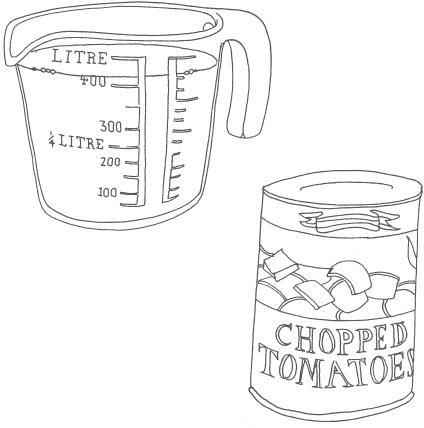The Thrifty Cookbook: 476 Ways to Eat Well With Leftovers (24 page)
Read The Thrifty Cookbook: 476 Ways to Eat Well With Leftovers Online
Authors: Kate Colquhoun
Tags: #General, #Cooking

BOOK: The Thrifty Cookbook: 476 Ways to Eat Well With Leftovers
8.15Mb size Format: txt, pdf, ePub
For a more aromatic, less Middle Eastern approach, leave out the cinnamon and add a bruised cardamom pod to the broth, remembering to remove it before serving.
Serves 2
about 850ml good clarified stock, ideally lamb or beef (see
pages 28
-
9
)
a good pinch of ground cinnamon
30-50g uncooked basmati rice, or 1 teacup leftover cooked rice
6-10 small meatballs (see
pages 144
-
5
)
a handful of fresh coriander or parsley, finely chopped
salt and pepper
Bring the stock to simmering point and add the cinnamon. Stir well and, if using raw rice, add it now. Simmer until the rice is a couple of minutes off being cooked. Add the meatballs and heat through thoroughly. If you’re using cooked rice, add it now. Season with salt and pepper, add the herbs and serve immediately, accompanied by flatbreads and a green salad.
Chicken ball broth
Use chicken or vegetable stock and add a couple of sliced bottled artichoke hearts per person. Before serving, add a squeeze of lemon, some really finely chopped chives or spring onions and a scattering of tender young parsley leaves.
Pork ball broth
Use a light meat or vegetable stock and omit the cinnamon. Fennel sliced so thinly that it is almost transparent would be a great addition, or very finely shredded cabbage.
Beef ball broth
Leave out the cinnamon and use beef stock, if you have it. Add skinned, deseeded and chopped tomatoes to the broth as it simmers. (Instead of beef balls you could use herb dumplings – see
page 135
.)
Leftover risotto broth
Elizabeth David gave a recipe for using cooked risotto in a soup, which sounds strange but is heavenly. Make small balls from the leftover risotto, adding chopped herbs if you like. Dip the risotto balls in egg and breadcrumbs, fry them in a little oil and then slip them into a simple chicken or vegetable broth (see Arancini,
pages 140
-1).
Leftover fish broth
Omit the meatballs and cinnamon, use fish stock and add a few defrosted Atlantic prawns, if you have them, quickly poached in the stock. Right at the end, drop in some pieces of leftover fish, just to warm though. Add a skinned, deseeded and chopped tomato, shredded baby spinach or fine rice noodles for variety.
Leftover meat broth
Tear leftover meat into strips and add them to a pan of simmering broth, giving them just enough time to heat through before serving.
Noodle broth
Add some egg or rice noodles, plus a handful of spinach, sliced mushrooms or Chinese leaves, to a pan of simmering broth and cook until they are just tender. Serve with some finely chopped spring onions.
The classic smoked fish soup is Scottish cullen skink, made with smoked haddock. Frankly, though, you can use just about any kind of smoked fish you have to hand, even oily fish such as kippers and mackerel. Indeed, the leftovers of a fish pie, thinned with a little milk and stock, warmed and blitzed in a blender, would make a fine alternative. If you are using leftover cooked fish and you don’t have any of your own fish stock (see
page 30
), it is worth buying some from your local fishmonger or supermarket. Like all soups, this one freezes well.
Serves 4
a little oil or butter 1 onion, chopped
450g smoked fish fillet (cooked or raw
)
about 570ml water (if using raw fish) or fish stock (if using cooked fish
)
225g leftover mashed potato
570ml milk
salt and pepper
cream or crème fraîche, to serve
a handful of parsley or chives, chopped, to serve
Heat a little oil or butter in a pan, add the onion and cook until softened. If you are using raw fish, add it to the pan, cover with water and simmer for 2-3 minutes. Remove the fish, allow it to cool, then remove the skin and check for bones. Break the flesh into large pieces and keep separate. The liquid in the pan forms the stock for the soup.
If you are using cooked fish, skin it, break the flesh into rough chunks and put on one side. Pour the fish stock over your onion base and bring to a slow simmer.
Stir the mashed potato into the simmering liquor and whisk until smooth. Add the milk and then add the fish. Simmer very gently for 3 minutes maximum, just to heat the fish through. Season to taste and serve each portion topped with a dollop of cream or crème fraîche and some chopped parsley or chives, accompanied by warm crusty bread.

The best stews (or casseroles, or whatever you want to call them) are made from scratch with raw meat or vegetables, wonderfully seasoned and cooked very, very slowly. The great thing about them is that they transform cheap cuts of meat into meltingly tender cold-weather comfort food – and they are practically impossible to mess up. Whatever is left over can be frozen for a ready meal later on or thinned with some good-quality stock and blitzed into a hearty soup.
If you have a fair bit of meat left over, though, there’s absolutely nothing wrong with making a stew with it – using up wilting vegetables at the same time. Unlike classic stews made from scratch, these are relatively fast, taking minutes rather than hours. As with soups (see
pages 53
-
68
), you start with a good base of softened onion and garlic, bulk up the meat with companionable vegetables, add the flavour and freshness of herbs and swathe the whole lot in a gravy made from stock, a can of tomatoes or other liquid.
Curries, whether you use a fresh array of spices or a ready-made curry powder or paste, are quick and almost effortless – certainly nothing exotically untoward – and if you keep them on the mild side most children will find them thrillingly different and gobble them up.
It’s worth repeating that cooked meat has already given up most of its juices and will only toughen if cooked again for too long. So with these dishes, the normal order of things is reversed: generally, the meat is added at the last minute, once the gravy or sauce has cooked and thickened, and it’s left only for as long as it takes to heat through completely. Remember that stews, like soups, can be among your very best friends in terms of combining flavours – almost anything goes. If you don’t find what you are looking for in the lists of variations here, you can easily adapt the basic process by taking inspiration from the recipes for soups on
pages 53
-
68
, or by using the What Goes with What list on
pages 26
-
7
.

Other books
Bond of Fire by Diane Whiteside
Peete and Repeat (The Frannie Shoemaker Campground Mysteries Book 3) by Karen Musser Nortman
El encantador de perros by César Millán & Melissa Jo Peltier
An Appetite for Murder by Lucy Burdette
Shatter My Rock by Greta Nelsen
STARGATE ATLANTIS: Dead End by Chris Wraight
Tuesdays at the Castle by Jessica Day George
Cha-Ching! by Liebegott, Ali
Nate Coffin's Revenge by J. Lee Butts
Latymer by Tracey Devlyn


